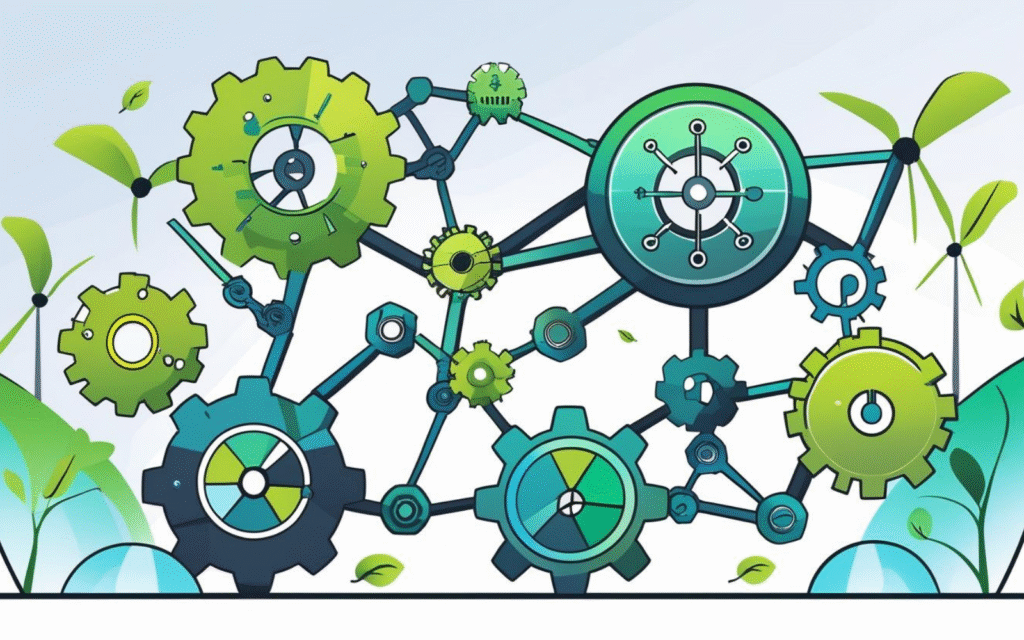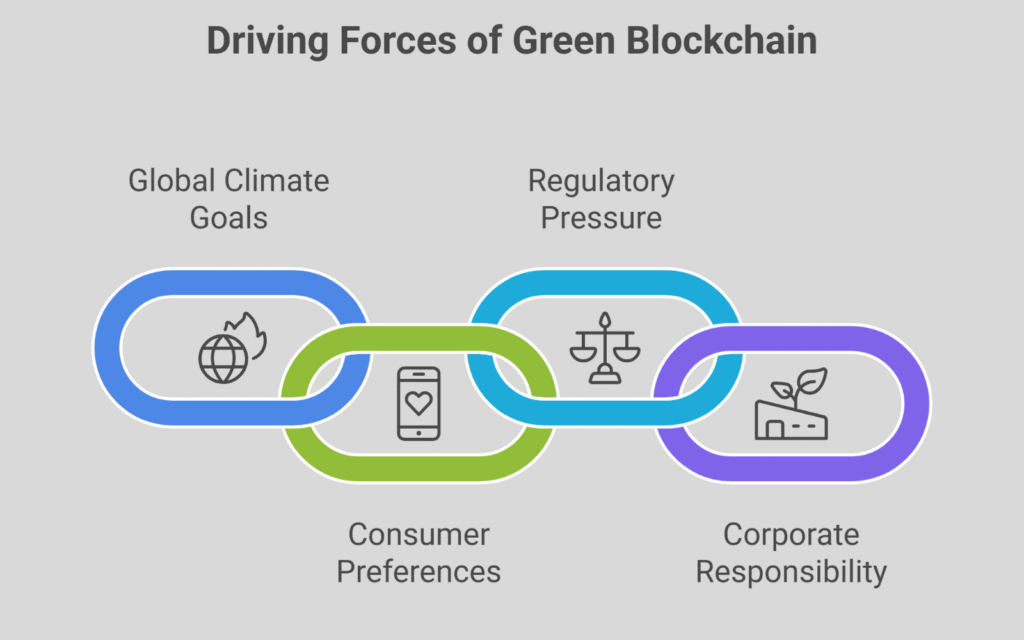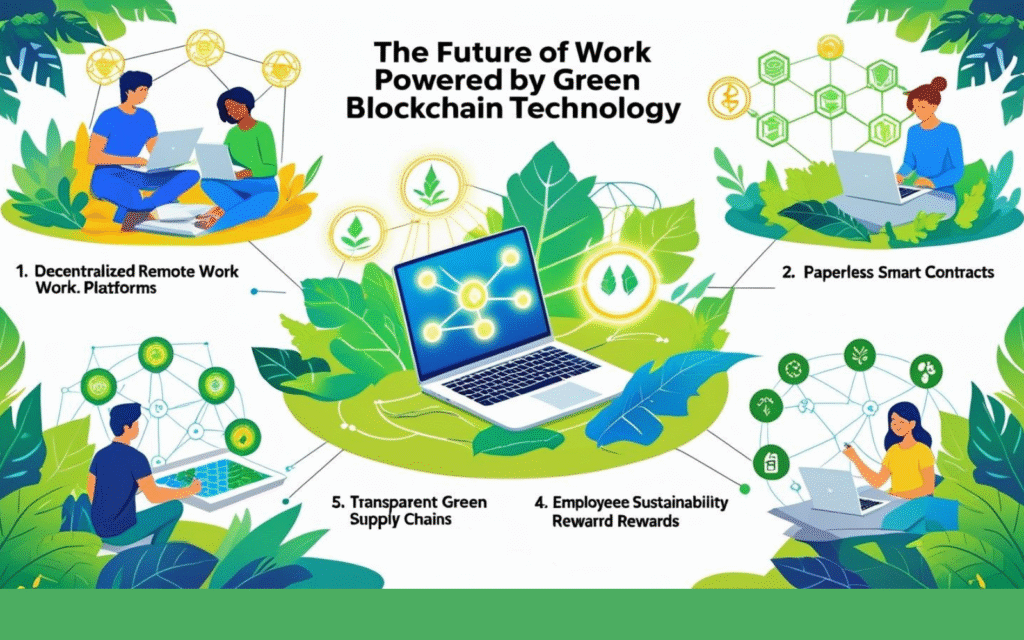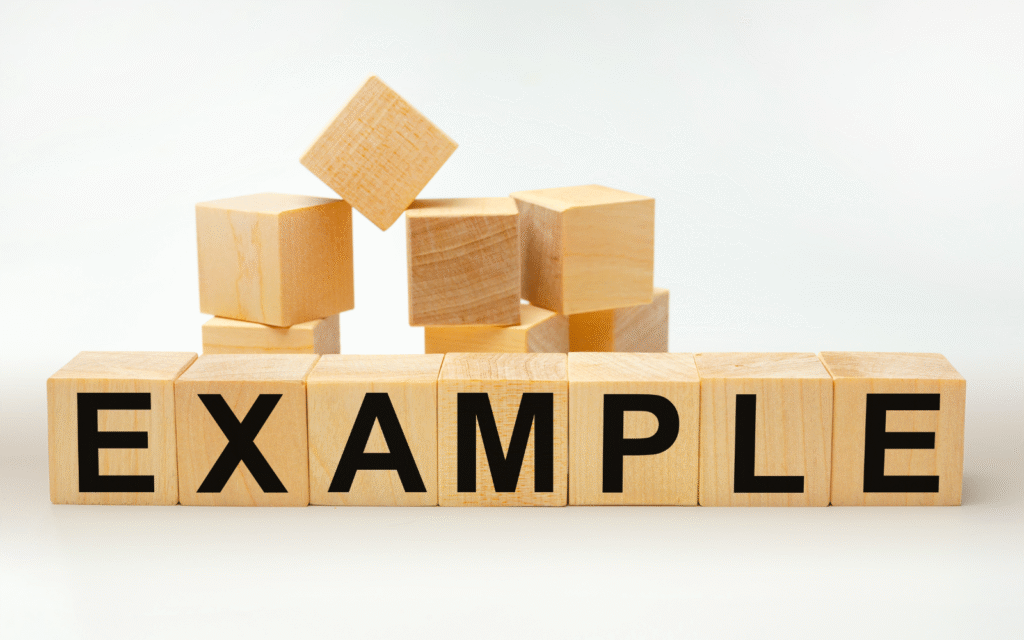How Sustainable Blockchain Technology is Shaping the Future of Work

Sustainable Blockchain Technology has moved from niche cryptocurrency circles to become a foundational pillar of global digital transformation. From secure payments to transparent supply chains, it now supports industries as diverse as healthcare, logistics, and creative content—delivering innovation while prioritizing environmental responsibility.
But in conjunction with this upward push came a noisy grievance—energy consumption. Bitcoin mining by myself once ate up more strength than complete international locations, raising moral and environmental worries. As governments, corporations, and customers develop greater eco-awareness, Green Blockchain has emerged as a powerful solution—one which aligns blockchain innovation with sustainability desires.
What exactly is Green Blockchain/Sustainable Blockchain Technology?

At its core, Green Blockchain refers to blockchain networks, gear, and practices that prioritize electricity performance, lessen carbon footprints, and integrate with broader environmental initiatives. Instead of depending completely on strength-extensive Proof-of-Work (PoW) mechanisms, these structures employ low-power consensus methods like:
- Proof-of-Stake (PoS) – Validators are selected based on stake, cutting energy use by way of over ninety nine%.
- Proof-of-Authority (PoA) – Pre-permitted validators ensure efficiency and agree with.
- Delegated Proof-of-Stake (DPoS) – Token holders vote for representatives to validate transactions.
- Hybrid Consensus – Combining distinctive models for balanced velocity, value, and sustainability.
Some systems take it in addition by:
- Running totally on renewable power resources (sun, wind, hydro).
- Offsetting emissions through carbon credit score purchases.
- Leveraging layer 2 answers to procedure transactions off-chain before batching them on-chain, lowering computational load.
Why Sustainability is Now a Blockchain Priority

The shift towards green blockchain isn’t a trend—it’s a necessity pushed by way of 4 effective forces:
- Global Climate Goals – International agreements like the Paris Accord are pushing industries in the direction of decreasing emissions.
- Consumer Preferences – Gen Z and Millennials call for eco-aware products and services, even within the digital sphere.
- Regulatory Pressure – Countries are introducing carbon taxes and sustainability reporting requirements.
- Corporate Responsibility – ESG (Environmental, Social, and Governance) compliance is now an aggressive necessity.
Organizations adopting sustainable blockchain answers—like those cautioned through Blockchain Australia Pvt Ltd—aren’t just protecting the environment, but also destiny-proofing their operations.
How Green Blockchain is Transforming the Future of Work

The place of work of the next day might be digital-first, without boundary lines, and sustainability-driven. Here’s how green blockchain is influencing this modification:
1. Decentralized Remote Work Platforms
Energy-green blockchain structures allow for stable painting contracts, payroll, and task tracking without the huge server electricity expenses of older structures. These platforms support mental wellness in the workplace by reducing the stress of traditional office environments while promoting sustainable work practices.
2. Paperless Smart Contracts
Smart contracts automate transactions and criminal agreements without printing an unmarried page—casting off waste and decreasing operational charges. This digital transformation aligns with how to create a green office space by eliminating paper waste entirely.
3. Transparent Green Supply Chains
Workers, suppliers, and consumers can affirm the eco-friendliness of merchandise immediately, constructing consideration and duty.
4. Employee Sustainability Rewards
Blockchain can issue tokens for sustainable place of business movements—which include lowering electricity utilization or choosing public transportation—which employees can redeem for benefits.
5. Cross-Border Team Collaboration
Green blockchain-powered platforms can securely shop task statistics and intellectual property at the same time as minimizing electricity use, allowing international teamwork.
Real-World Examples of Green Blockchain in Action

1. Ethereum’s Merge (Global)
When Ethereum switched from PoW to PoS in September 2022, its electricity utilization dropped by means of over ninety nine.Nine%—a flow that became a model for the industry.
2. Power Ledger (Australia)
An Australian blockchain startup enabling peer-to-peer renewable electricity trading, letting households promote surplus sun power to acquaintances.
3. VeChain
Used in supply chain management, VeChain tracks sustainable practices in industries like agriculture and fashion, assisting businesses show eco-claims.
4. Algorand
A carbon-negative blockchain that offsets its emissions via partnerships with environmental projects.
5. Blockchain Australia Pvt Ltd Initiatives
Helping corporations transition to low-electricity blockchain systems at the same time as staying compliant with rising environmental and financial guidelines.
Industry Data: The Numbers Behind the Shift

- Eighty% of commercial enterprise leaders say sustainability is now a “middle enterprise method” in preference to a PR initiative.
- $4.3 trillion – Estimated cost of ESG-focused digital transformation tasks by using 2030.
- 99.Ninety five% – Average electricity discount from switching PoW to PoS.
- 3x Growth – The global marketplace for inexperienced blockchain solutions is expected to triple among 2024 and 2028.
How Businesses Can Adopt Green Blockchain
- Step 1: Audit Energy Use – Understand the environmental impact of your modern-day blockchain or IT structures.
- Step 2: Choose the Right Consensus Model – Shift to PoS, PoA, or hybrid systems.
- Step 3: Integrate Renewable Energy – Use green-powered statistics centers or cloud structures.
- Step 4: Partner with Experts – Work with experts like Blockchain Australia Pvt Ltd to ensure compliance and exceptional practices.
- Step 5: Educate Teams – Train personnel on sustainable virtual practices to maximize effect.
Challenges Ahead
While promising, green blockchain adoption faces hurdles:
- Perception Issues – Many nevertheless assume blockchain = high electricity use.
- Cost of Transition – Migrating systems may be expensive in advance.
- Lack of Standardization – No generic carbon monitoring approach for blockchain but.
- Interoperability Concerns – Green blockchain have to combine smoothly with existing structures.
The Future Outlook: 2025–2035
The next decade will see blockchain becoming a chief driving force of sustainable virtual economies:
- ESG-Driven Job Roles – Blockchain compliance officers and sustainability auditors can be in high demand.
- Tokenized Carbon Credits in HR – Employees may be rewarded in tradeable credit for green movements.
- Green DeFi (Decentralized Finance) – Lending and funding platforms built completely on carbon-neutral blockchain networks.
- AI + Blockchain Sustainability Engines – AI predicting environmental impact in actual time and blockchain verifying consequences.
Why Australia Could Lead the Green Blockchain Movement
Australia has:
- Abundant renewable electricity assets.
- A developing blockchain skills pool.
- Strong regulatory engagement.
Blockchain Australia Pvt Ltd performs a vital role here—imparting training, strategic consulting, and integration services for groups eager to adopt eco-friendly blockchain structures.
Final Thoughts
The concept that generation and sustainability are in struggle is old. Green blockchain proves they are able to evolve collectively—unlocking transparency, performance, and eco-responsibility in one bundle.
In the coming years, the businesses that thrive could be those who innovate responsibly, balancing present day virtual systems with environmental stewardship.
With leaders like Blockchain Australia Pvt Ltd using adoption, the world is properly on its way to constructing a low-carbon, excessive-tech future of work.
Frequently Asked Questions
What is Green Blockchain and how is it different from traditional blockchain?
It’s a blockchain designed for energy efficiency and low carbon impact, using methods like Proof-of-Stake instead of energy-heavy Proof-of-Work.
Why is sustainability becoming a priority in blockchain development?
Climate goals, consumer demand, regulations, and ESG commitments make eco-friendly blockchain essential for long-term success.
How can Green Blockchain influence the future of work?
It powers secure remote work, paperless contracts, transparent green supply chains, sustainability rewards, and low-energy global collaboration.
Are there real-world examples of Green Blockchain in action?
Yes, Ethereum’s PoS shift, Power Ledger’s renewable trading, VeChain’s supply chain tracking, and Algorand’s carbon-negative model.
What challenges do organizations face in adopting Green Blockchain?
Misconceptions, high transition costs, no carbon-tracking standard, and integration issues.
